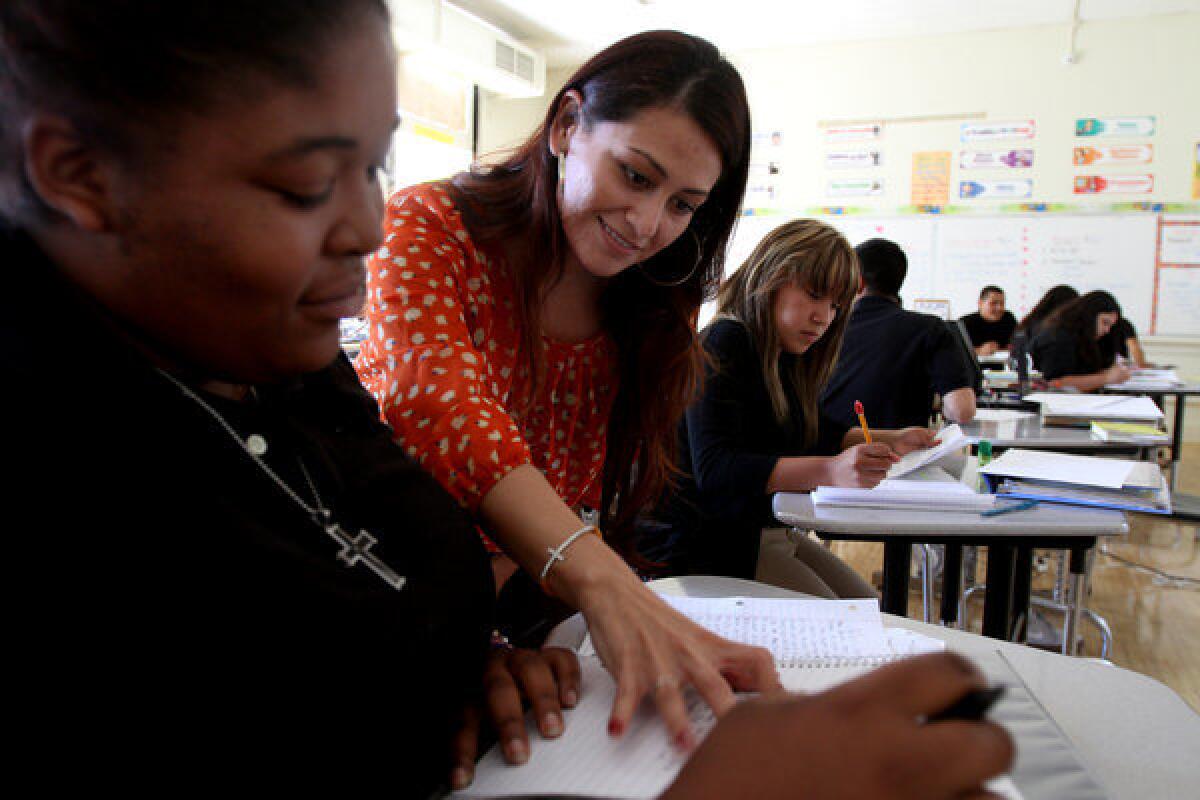State academic performance slips, but L.A. Unified improves

California public schools lost ground this year in overall academic performance for the first time in a decade, but more than half met state goals for achievement on reading and math standardized tests, according to data released Thursday.
Los Angeles Unified bucked the statewide decline, recording the second highest gain in academic performance among the state’s 10 largest school districts. Among them, Los Angeles, San Diego Unified and San Bernardino City improved over last year but the other seven slipped, reflecting a dip that officials have attributed to severe budget cuts and new national learning standards being phased in.
L.A. Unified Supt. John Deasy said he was “pleasantly stunned” by the district’s strong performance compared to the state. Students struggling with English recorded the largest gains in district history, and those with disabilities and lower incomes also boosted their achievement with improvements that outpaced the statewide average. African American and Latino students also did
better than their peers in California.
“These are the fruits of a very focused agenda,” Deasy said. “We have continued to grow despite the absolute worst in budget cuts and that is testament to the quality of our employees and how hard our students are working.”
The achievement ratings, called the Academic Performance Index, are based on a 1,000-point scale compiled from standardized test scores. They are widely viewed as a comprehensive marker of school quality, affecting property values and triggering penalties, among other effects.
A Watts charter school that took over half the campus of low-performing Jordan High School two years ago posted the highest gains in the state. Staff members at Animo College-Prep Academy, operated by Green Dot Public Schools, credited the success to sweeping changes they introduced in
school culture, organization, academic support programs, teacher selection and training and other improvements.
Animo students said the school has boosted their achievement -- and academic ambitions -- with better teachers, stricter discipline and higher expectations.
“We’re very proud of the school and the area,” said Yaqueline Parra, a 16-year-old Animo senior. “People always talk about how we’re the worst kids who live in a ghetto but now look at us.”
Other schools with significant improvement included several operated by the Partnership for Los Angeles Schools, a nonprofit launched by former Mayor Antonio Villaraigosa to turn around some of the district’s most low-performing campuses. Mendez Learning Center and several schools on the
Roosevelt High School campus recorded gains of more than 50 points, some of the
largest in the state. Roosevelt High School Magnet surpassed the state’s benchmark of 800 points for the first time.
Joan Sullivan, the partnership’s chief executive officer, attributed the improvements to its transformation model that focuses on recruiting and training strong principals and teachers, using technology to address individual student needs and increasing parent involvement and education.
“We’ve built really strong momentum,” Sullivan said.
Deasy noted that Animo, the Roosevelt schools and other top performers were those targeted by the district for intensive support or freed to incorporate innovative reforms. Overall, traditional campuses did not keep pace with the district’s increase of 3 points to 749, he said.
Statewide, the performance rating dipped by 2 points to 789. But the percentage of schools that met the state goal of 800 points has more than doubled in the last decade to 51% this year from 21% in 2003.
Those gains have come despite $20 billion in state budget cuts, prompting the loss
of 30,000 teachers, a shorter school year, larger classes and cuts in summer school, after-school programs and other offerings that educators say help boost achievement.
In other test results released Thursday, 95.5% of California students in the class of 2013 passed the mandatory high school exit exam, the highest rate since it was made a graduation requirement in 1999.
“Despite the very real challenges of deep budget cuts and the ongoing effort to shift to new, more demanding academic standards, our schools persevered and students made progress,” State Supt. of Public Instruction Tom Torlakson said in a statement.
But he criticized federal performance standards that require nearly 90% of students at low-income schools receiving Title I federal funds to be at grade level for reading and math. Only 14% of 9,861 such schools met that federal benchmark although nearly one-third of them achieved the state performance goal.
“It is unfortunate that officials in Washington continue to enforce a program they have acknowledged is deeply flawed, and that paints too many high-achieving schools with the same broad brush,” Torlakson said, vowing to push for changes in the federal law.
[For the Record, 12:05 p.m. PDT Aug. 29: An earlier version of this online article said the statewide API figure dipped 2 points to 798. The number did decline 2 points, but to 789.]
ALSO:
California scores dip slightly
Fast-food workers protest for higher wages
Hundreds more join fight against Yosemite fire
Twitter: @TeresaWatanabe
More to Read
Sign up for Essential California
The most important California stories and recommendations in your inbox every morning.
You may occasionally receive promotional content from the Los Angeles Times.











